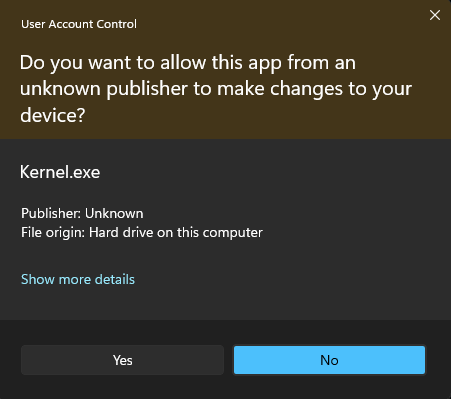How Kernel Works
Kernel is designed to make software installations quick and easy. It begins by conducting routine checks to ensure that all installations can be performed correctly. Once that's done, it starts downloading the necessary setups for the software you've selected. To speed up the process, Kernel performs these actions asynchronously, all at once in chunks. This approach results in faster completion times without being resource-heavy. Additionally, Kernel uses silent install switches to perform the installations, which means that no unwanted components, such as toolbars, junk, or bloatware, are installed.
Full Explanation
Why was Kernel Developed?
Installing many applications on Windows can be frustrating and confusing, which can discourage users from trying out certain software. Removing these issues can improve the user experience and make tasks such as those of a Network or Systems Administrator much easier. Installing a bulk of software on a fresh Windows installation can take hours, and finding each software provider's official site, downloading the setup, and going through the installation process is a tedious and annoying process. Kernel aims to simplify the installation process, making it as straightforward as mobile installations. For example, mobile installations are often easier, as users can simply go to a central location (such as an app store) and click 'install' to install an app.
- Why has this issue not been addressed yet?
The solution to the complex and frustrating setup processes of many apps on Windows is not as straightforward as with something like a mobile app installation. For example, some apps require the use of the command line for installs, which may be intimidating or confusing for some users. While these apps may offer advanced features and functionality, they may also have a learning curve that can be off-putting for some users. In contrast, Kernel aims to remove these barriers to entry by making the process of installing programs as easy as possible: choose a program, download it, and run it. This approach ensures that Kernel is accessible and user-friendly for individuals with varying levels of technical expertise.
Specs
Supported OS: Windows 10, 11
Framework: .NET 9.0
Language: C#
Project type: WPF App
How installs are performed
Silent install switches are a set of command-line parameters that are used to perform installations without requiring user interaction. These switches are commonly used in software installations where the user is not required to provide input during the installation process. This allows for the installation to be performed in the background, without any user intervention.
The use of silent install switches in Kernel means that the installation process is automatic and unattended. This means that the user does not have to manually intervene during the installation process, and can instead focus on other tasks. Additionally, the use of silent install switches means that there is less risk of errors occurring during the installation process due to user input errors.
Overall, the use of silent install switches in Kernel makes the installation process simpler, faster, and less prone to errors. It also frees up the user's time and attention to focus on other tasks while the installation process is running in the background.
Silent Switches Used - /silent, /S, -s, -silent, --silent, /VERY SILENT, /qn, --quiet.
How does Kernel know which installations you want to perform?
With each app you choose to install, a value is stored and when you click download, a custom Kernel.exe file is generated. The values of the software you selected is stored within the .exe itself hence it being custom/unique to each user.
Possible Choices
Note: Case-sensitive, commas aren't required
Apps Section
~Chrome, ~Firefox, ~Fire.foxdevedition, ~Brave, ~Opera, ~GX, ~Vivaldi, ~qBittorrent, ~SevenZip, ~7ZipDarkMode, ~PeaZip, ~Discord, ~TeamSpeak, ~Zoom, ~Teams, ~Slack, ~Pidgin, ~Trillian, ~Thunderbird, ~Gyazo, ~ShareX, ~Blender, ~Gimp, ~Krita, ~Paintdotnet, ~Spotify, ~iTunes, ~VLC, ~Foobar2000, ~Winamp, ~MusicBee, ~Audacity, ~AIMP, ~KLiteCodecs, ~Mediamonkey, ~Steam, ~UbisoftConnect, ~RSGames, ~NvidiaDesktop, ~NvidiaLaptop, ~LGHub, ~LGS, ~iCUE, ~MSIAfterburner, ~EAapp, ~EpicGames, ~Battlenet, ~PSPlus, ~xenia, ~RPCS3, ~OpenHardwareMonitor, ~LibreHardwareMonitor, ~HWiNFO, ~FurMark, ~CrystalDiskMark, ~Cinebench, ~VisualStudio, ~NoNetWeb, ~AddAzure, ~AddPython, ~AddNodejs, ~AddNetCrossPlat, ~NoManagedDesktop, ~AddNativeDesktop, ~AddUniversal, ~AddNativeMobile, ~AddManagedGame, ~AddNativeGame, ~AddStorage, ~AddScience, ~AddVSExtension, ~AddOffice, ~AddNativeCrossPlat, ~NoRecommended, ~AddOptional, ~VSCode, ~dotUltimate, ~NoPerMachine, ~NoReSharper, ~NodotTrace, ~NodotMemory, ~NodotCover, ~NoReSharperCpp, ~TeamCity, ~NoRider, ~Rider, ~IntellijIDEA, ~JetBrainsToolbox, ~Neovim, ~Notepadpp, ~RStudio, ~RLanguage, ~Mssql, ~SSMS, ~Mysqlserver, ~Mysqlworkbench, ~Postgresql, ~Cmder, ~FileZilla, ~GitHub, ~Putty, ~WinSCP, ~WinMerge, ~AutoIt, ~Dropbox, ~GoogleDrive, ~OneDrive, ~SugarSync, ~Evernote, ~Everything, ~Revo, ~NVDA, ~KeePass2, ~GoogleEarth, ~TeamViewer, ~Wireshark, ~Npcap, ~Win10pcap, ~VirtualBox, ~VMwarePlayer, ~VMwarePro, ~OBS, ~Rufus, ~Start11, ~RBTray, ~RBTrayStartup, ~Redistx64, ~Redistx86, ~DirectX
Windows 11 Settings
`Showall, `Hideall, `Hidechat, `Showchat, `Hidetaskview, `Showtaskview, `Hidewidgets, `Showwidgets, `Hidesearch, `Showsearch, `Leftalign, `Middlealign, `Hidebin, `Showbin, `Hidebluetooth, `Showbluetooth, `Smallicons, `Mediumicons, `Showseconds, `Hideseconds, `Disableprecision, `EnablePrecision, `Disablenotifications, `EnableNotifications, `Smallcursor, `Uninstallbloatware, `Uninstallonedrive, `Darkmode, `Lightmode, `Showcompactview, `Hidecompactview, `Hidecheckboxes, `Showcheckboxes, `Showhiddenitems, `Hidehiddenitems, `Showextensions, `Hideextensions, `Showfullpath, `Hidefullpath, `Hidehome, `Showhome, `Hiderecentlyusedfiles, `Showrecentlyusedfiles, `Showrecyclebinex, `Hiderecyclebinex, `Hidegallery, ~Showgallery, `Transparency, `Notransparency, `Showaccentcolorstart, `Hideaccentcolorstart, `Showaccentcolorborder, `Hideaccentcolorborder, `Blackborders
Does Kernel have a Code Signing Certificate?
ATM no, once Kernel gains a decent userbase and development is complete, a certificate will be obtained.
- Running Kernel.exe will prompt for UAC each time because the app requires admin permissions.
